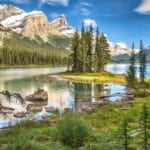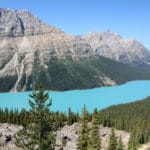Dear reader: This article contains links to products and services that I may be compensated for, at no extra cost to you.
Banff National Park is the first, and to this day most popular of Alberta’s and Canada’s national parks.
Dotting the park’s majestic landscape is a series of lakes so vibrantly turquoise in color that one can’t help but wonder whether Parks Canada is secretly dumping powdered paint into them at night to attract the masses of tourists.
The truth is that these sublime lakes in Banff are Mother Nature’s fine work. Most are glacially fed, and the glacial silt suspended in their meltwater lights up under rays from the sun. Truly jaw-dropping, the most beautiful lakes in Banff deserve their spot at the top of any Alberta bucket list.
Surrounded by the most dramatic, snow-capped peaks and immense glaciers of Canada’s Rocky Mountains, Banff’s lakes offer a wealth of activities, whether you’re battling the crowds in summer or looking for things to do in Banff in winter. Combine these with some of the remoter lakes in Jasper National Park to the north and Kananaskis Lakes & Waterton Lakes to the south and you’ll have all the makings of an unforgettable Canadian Rocky Mountains road trip!
In this article, I’ve narrowed it down to the 15 best lakes in Banff that are easily reached, even if you’re traveling to Banff with kids. This means you can either drive right to them (many are right beside the main highway) or access them on a short walk–the perfect makings for an epic lake-hopping road trip!
I’ve also included a few gems that only require a hike of two hours or less and can be done with kids. To find out how to fit the best of these lakes into a short visit, consult my recommended 3-day Banff itinerary. With even less time, see how to do Banff in 24 hours.
Pick up the latest Lonely Planet Banff, Jasper, & Glacier National Parks for planning your trip!
Table of Contents
Best Lakes Around Banff Town
The first four lakes on this list are located within a short drive from Banff town. The first one can even be reached on foot, while the other three are accessible on public transportation in the summer high season.
While they aren’t the most famous of Banff National Park’s lakes because they mostly lack the classic teal color of the lakes along the Icefields Parkway, each is striking nonetheless.
They are particularly abundant in opportunities for activities in summer and winter alike, and for this reason they are some of the best lakes in Banff to visit with kids.
1. Vermilion Lakes
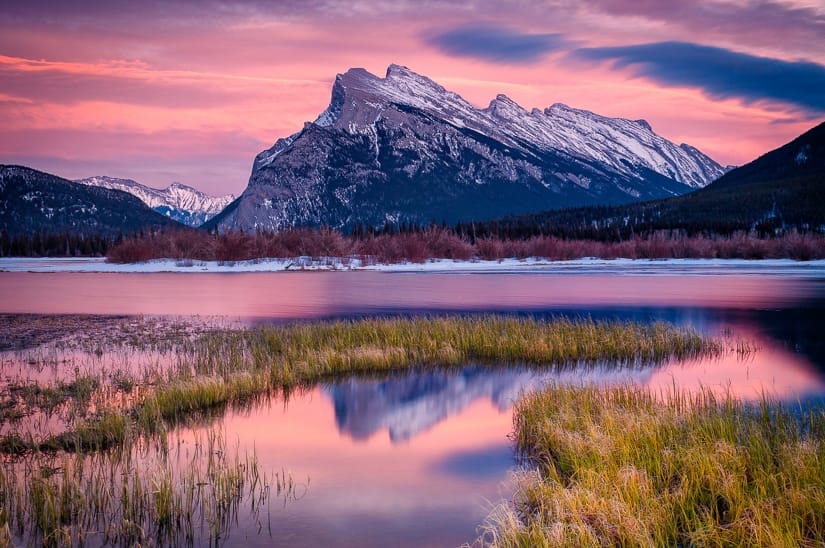
The Vermilion Lakes is a collection of marshy lakes along the bow river just west of Banff town. There are three main lakes and many smaller ponds. They are the closest lakes to Banff town and the perfect place to escape the busy town center without journeying too far.
While the lakes don’t have the classic turquoise color of other Banff Lakes, they are nevertheless calm respites and offer gorgeous views of Mount Rundle and Sulphur Mountain, which often reflect on the water. They are also great for kayaking, canoeing, and stand-up paddleboarding.
Sunrises and sunsets on Vermillion Lakes are particularly inspiring, especially when sitting on one of the docks on the lakeshore.
Getting to Vermilion Lakes: Access Vermilion lakes from Mt. Norquay road, which is the main road leading into Banff at the western end of town. From Mt. Norquay Road, turn onto Vermilion Lakes Road, which runs along the lakes.
On foot, it takes about 30 minutes to reach Vermilion Lakes from the Banff town center.
There’s also a lookout right on Highway 1, called Vermilion Lakes Viewpoint on GoogleMaps, but it’s much better to get right down beside the lakes.
In Banff town, I recommend Mount Royal Hotel (see on Booking / Agoda / TripAdvisor), which is right downtown on Banff avenue and has hot tubs on the roof.
2. Lake Minnewanka
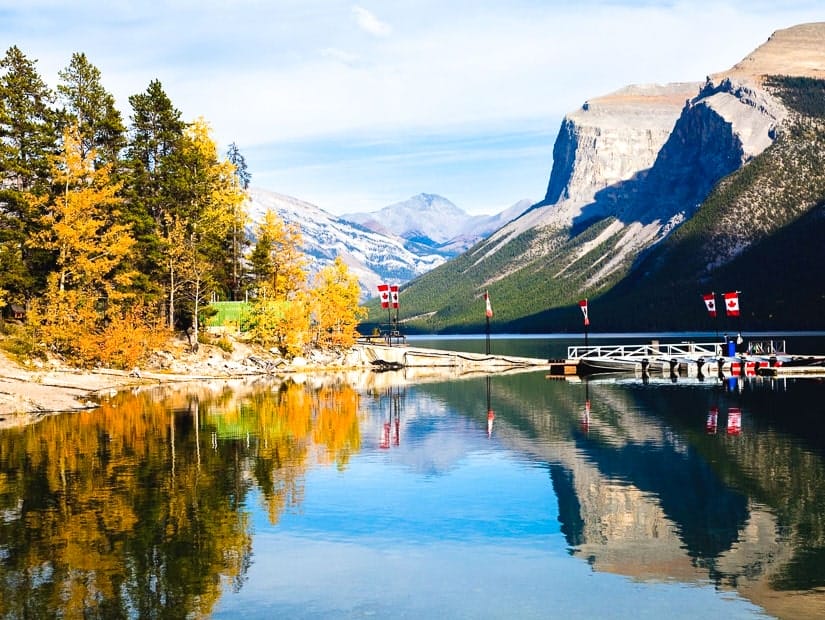
Magnificent, elongated Lake Minnewanka is the largest lake in Banff National Park, and one of the most enticing. It stretches for 21 kilometers, flanked by towering peaks like Mount Inglismaldie, Girouard, Costigan, and Saddle Peak.
The name is derived from Minn-waki (Lake of the Spirits), the name first given to it by the Stoney Nakoda indigenous people.
From the parking lot on the western tip of the lake, boat tours depart for Devil’s Gap at the eastern end. It is also the start of the Lake Minnewanka Lakeside Trail. There’s a small snack shop, Snack Anchor, at the start of the trail.
In summer the lakeside is a popular spot for picnics, boating (one of the few where this is allowed), fishing (national park fishing permits required), biking and even scuba diving.
In winter, it’s great for snowshoeing, and it is one of the best spots in Banff for seeing frozen methane ice bubbles (take caution and do your research before walking in the ice!) For the absolute best spot to see ice bubbles, though, see #15 in this article.
On the way out, also check out Bankhead Ghost Town!
Getting to Lake Minnewanka: The western end of the lake is accessed on Lake Minnewanka Scenic Drive, which passes along Two Jack Lake (see next extry) before reaching Lake Minnewanka. It’s 13 km (15 minutes) from Banff town.
You can also reach the lake by public transportation on Roam Bus route 6 (mid-May to mid-September).
3. Two Jack Lake
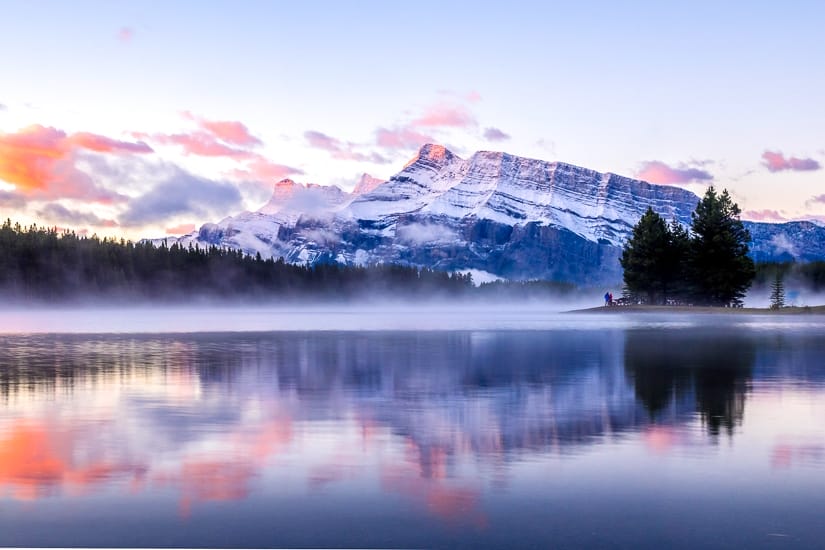
A small branch of Lake Minnewanka, Two Jack Lake is tiny in comparison, but offers equally stunning views. Because it is so close to Banff town, it is understandably popular.
Two Jack Lake is also the site of Two Jack Lake Campground, which includes a lakeside section and a main section on the other side of Lake Minnewanka Scenic Drive. Sites sell out fast, especially on the lakeside!
The lake is popular for canoeing, kayaking, SUP, and fishing, and in winter you can even skate on the lake early in the season before it gets covered with snow, usually around December.
From the northern end of the lake, you can enjoy a majestic view of Mount Rundle to the south.
Getting to Two Jack Lake: The lake is 10 km (12 min) from Banff town on Lake Minnewanka Scenic Drive. The main parking lot is a minute past the turnoffs for the campgrounds. There is also a lookout pullover at the end of the lake, at the point where it connects to Lake Minnewanka.
You can also access the lake from Banff on Roam Bus route 6 (May 21 to Sept 19).
For more impressive lakes in Alberta beyond Jasper & Banff, you can find several in my guides to places to visit around Red Deer and things to do in Canmore.
4. Johnson Lake
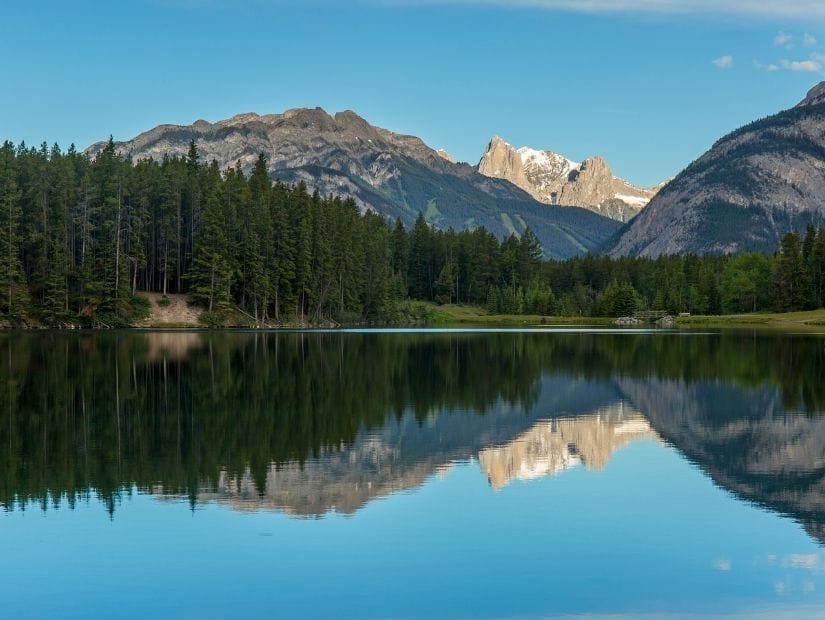
In the same area as Lake Minnewanka and Two Jack Lake, Johnson Lake is another well-known spot, albeit not as popular as the above two.
What attracts most people to Johnson Lake is the fact that it has one of the few beaches in Banff National Park. Come here for suntanning or swimming; the water isn’t quite as cold because the lake is not glacial fed, but that also means it doesn’t have the famous teal color.
The best way to appreciate the lake is by walking the Johnson Lake Trail around the lake (3.1 km/1 hr).
There are two swings by the lake that you can try to track down. About one kilometer along the trail on the north side, there’s a sitting swing, but you’ll have to watch for it, as it’s located above the trail. About a kilometer along the south side of the lake, there’s also a rope swing that you drop right into the lake from. See more info and photos of them here.
Getting to Johnson Lake: Like the above two lakes, Johnson Lake is located on the Lake Minnewanka Scenic Drive. There’s a turnoff for it a few minutes before Two Jack Lake. Roam Bus route 6 also stops here.
Read about why I only travel with a mirrorless camera and other essential travel items I always use.
Best Lakes on Banff’s Icefields Parkway
No visit to Banff is complete without laying eyes upon one, or ideally many of the surreal, teal-colored glacially fed lakes along the Icefields Parkwark. These are without a doubt Banff National Park’s most iconic attractions, and one of the top reasons why Alberta gets my vote for Canada’s most beautiful province.
The below lakes are listed in the order you will encounter them driving north from Banff townsite along Highway 1 to Lake Louise and then Highway 93 (the Icefields Parkway) as it meanders north toward Jasper National Park.
Because most of the lakes are on the west side of the highway, shooting photos in the morning is best, otherwise you’ll find yourself battling glare from the sun.
To continue your Rocky Mountain Lakes tour as you venture north, see my guide to the best lakes in Jasper National Park.
5. Lake Louise
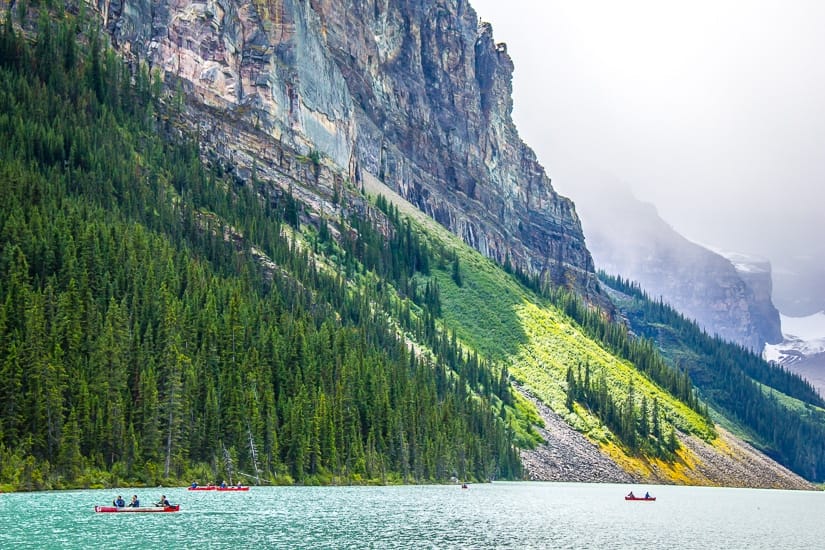
Lake Louise is the famous famous lake in Banff National Park, and arguably, all of Canada. Overrated it is not; this lake has attracted admirers since the turn of the 20th century, when Canadian Pacific Railway first built the original Chateau Lake Louise Hotel (see on Booking / Agoda / TripAdvisor) on the lake’s eastern shore.
Besides the lake’s unbelievable turquoise color, what makes it truly stunning is that it encircled by a wall of sheer peaks and glaciers. Massive Victoria Glacier is suspended high above the lake on the opposite shore.
Most visitors walk the lakeside paths, while a network of hiking trails lead to various lookout points. There are activities galore at the lake, including high tea inside the hotel or hiking up to Devil’s Thumb for an incredible view looking down on Lake Louise and Lake Agnes.
In winter skating on the frozen lake is a once-in-lifetime experience. Our kids’ first time ever ice skating was an Lake Louise, and we will never forget it!

You can stop for equipment rentals in Lake Louise village, while across the highway, Lake Louise Ski Resort is the most famous of Banff’s three ski resorts.
Due to its immense popularity, it is becoming increasingly difficult to visit Lake Louise. At peak times, you’ll have to come at 5 a.m. for any chance of getting a parking space, or take the shuttle bus (see below).
Getting to Lake Louise: If you want to guarantee a visit (and especially if you want to see nearby Morraine Lake in the same day), taking the Lake Louise and Moraine Lake shuttle from Banff is high recommended. You must make a reservation in advance on the same website as national parks camping reservations. You can also take Roam Bus route 8S from Banff year-round.
If visiting by car, Lake Louise is 57 km (40 min) from Banff town on Highway 1 (Trans Canada Highway), just before it veers west into British Columbia.
6. Moraine Lake
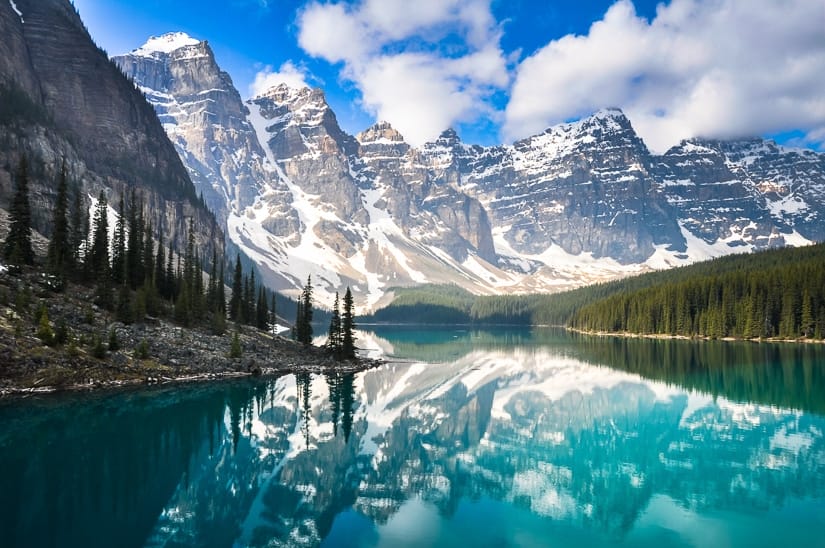
Is Moraine Lake even more beautiful than Lake Louise? Many would say so.
This absolutely breathtaking Rocky Mountain gem is every bit as iconic as Lake Louise, and even appeared on the Canadian $20 banknote from 1969 to 1979.
Nothing can compare to the view looking across the lake from the huge rockpile (or glacial moraine, hence the lake’s name) to the immense Valley of the Ten Peaks. Also watch for super cute pikas as you climb the moraine! Moraine Lake is also the starting point for the incredible Larch Valley hike, where the larch trees exhibit vibrant colors for two magical weeks in early autumn.
Moraine Lake is only open from June to mid-October every year (varies depending on weather). Also, due to massive crowds, private vehicles are no longer allowed on the access road, so you’ll need to take a shuttle to get there. I recommend this shuttle company, which is family-owned and the only one that goes early enough for sunrise.
Getting to Moraine Lake: It’s a winding 12 km drive from Lake Louise Drive to Moraine Lake, no private cars allowed. Reserve your shuttle bus here.
7. Lake Agnes
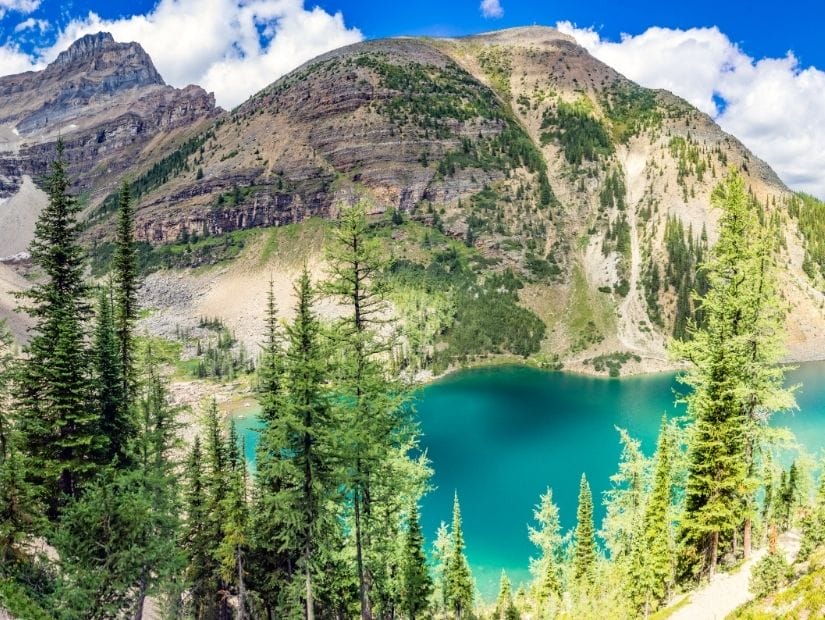
If you make it to Lake Louise, hiking up to Agnes Lake is a super worthwhile add-on.
The hiking trail to Lake Agnes rises steadily from the shore of Lake Louise, granting incredible views looking down on Lake Louise, before reaching Lake Agnes Tea House. Sip on some tea or enjoy a pastry while looking over the pretty alpine lake, backed by Mount Niblock and Mount Whyte.
You’ll need to budget at least two hours return for the hike, with an elevation gain of 435 meters. The first part is a little steep but can still be done with older kids. It can get quite busy at peak times.
Getting to Agnes Lake: The 7.4-km return hike begins on the shore of Lake Louise, veering off from the lakeside path just past Chateau Lake Louise.
8. Consolation Lakes
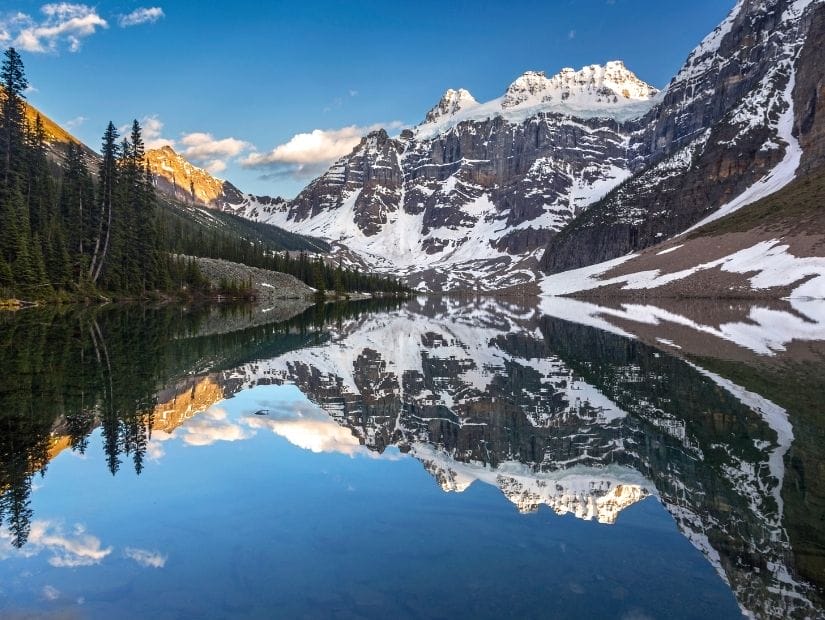
Just as Agnes Lake is a great add-on to Lake Louise, Consolation Lakes is an excellent side trip from Moraine Lake.
From just behind the rock pile at Moraine Lake, a 6 km trail leads to the first of two gorgeous alpine lakes, with another kilometer to reach the second one.
In total, there’s about 250 meters of elevation gain and the hike can be done in less than two hours return, even with kids.
Getting to Consolation Lakes: Follow this trail guide from the main parking lot at Moraine Lake. See the Moraine Lake section above for information on getting there, keeping in mind that the Moraine Lake road is closed in winter.
9. Herbert Lake
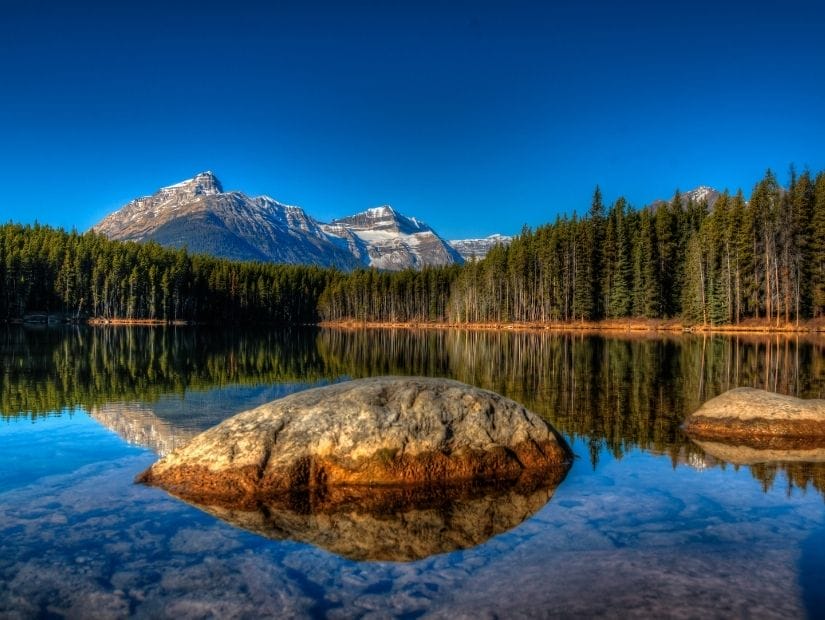
After turning off Highway 1 (Trans-Canada Highway) to Highway 93 (Icefields Parkway), Herbert Lake is the first notable lake that will tempt you to stop.
This tiny but extremely pretty lake doesn’t see the same tourist masses as Lake Louise, Moraine Lake, or Peyto Lake, with most tourists bypassing it in a rush to get to the others.
From the parking lot, a short trail leads to the lake shore, or you can walk all the way around the lake in only about half an hour.
On the opposite side, you can even jump off a small diving board, if you’re brave enough to handle the cold shock.
When the water is calm enough, usually around dusk or dawn, you can see Mount Temple reflecting on the surface of the lake.
Getting to Herbert Lake: The lake is three kilometers up the Icefields Parkway. Watch for the turnoff and small parking lot on the left. It’s a 45-minute drive from Banff town.
10. Hector Lake
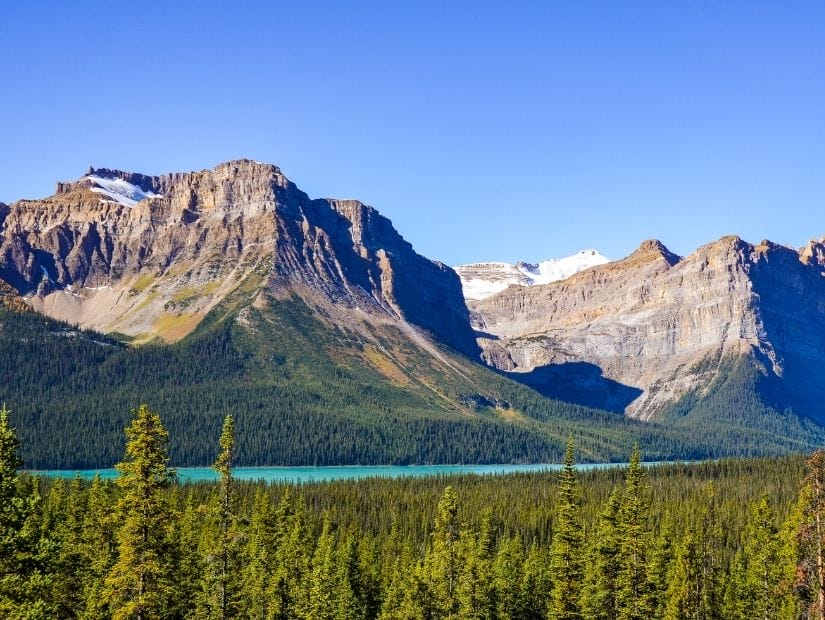
The second of two lakes with old man names starting with H (this one is actually a surname, after geologist and naturalist James Hector), Hector Lake can be viewed, just barely, from a pull-over on the highway.
A thin strip of Hector Lake’s turquoise surface is visible at the base of a commanding row of mountains, with trees obscuring part of the view. Watch for the viewpoint, as it’s easy to miss.
Better yet, park your car and walk to the lake’s shore. The trail is easy but not well marked, and you may have to cross a few sections of the Bow River as it branches out before emptying into the lake. It’s best to follow the map in the above link.
There’s also a trail to a basic walk-in campsite on the lake’s short, but it’s best to avoid that trail, which involves fording a wide section of the Bow River.
Getting to Hector Lake: The Hector Lake Viewpoint is 78 km (55 min) from Banff townsite and 22 km (15 min) from Lake Louise. Watch for the small pullover on the left side of the highway; it’s not well marked.
11. Bow Lake
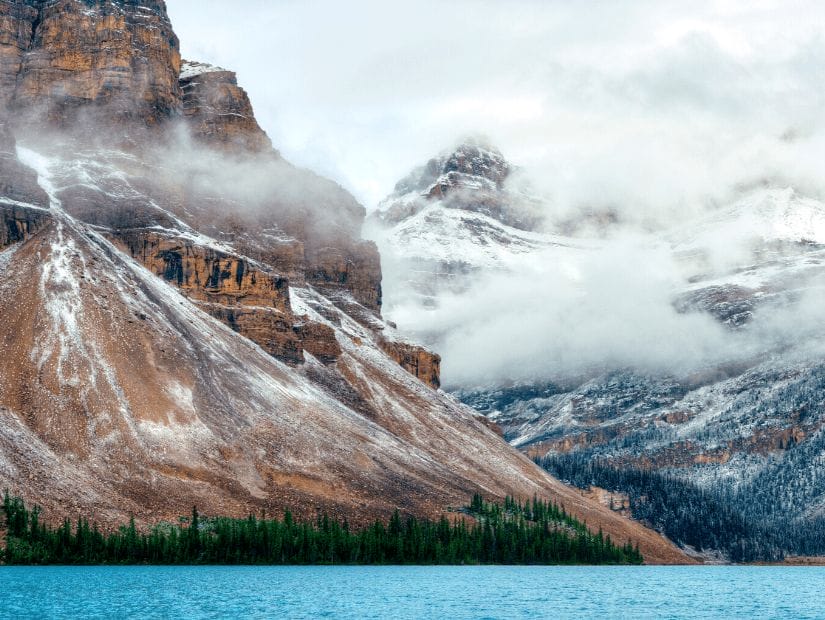
Next up is Bow Lake, one of the most beautiful lakes in Banff on the Icefields Parkway (after the big three of Louise, Moraine, and Peyto, of course), and Highway 93 runs right along the shore of the turquoise colored glacial lake.
Bow Lake is the source of Bow River, which runs all the way through Banff and on to Calgary. From the shore at the parking lot, you can admire impressive views of the lake to Bow Glacier on the opposite side.
This is also the start of an easy (but may be long for some) 8.9 km return hike to the beautiful Bow Glacier Waterfall, one of the most beautiful waterfalls near Calgary.
On the highway, you’ll also have a chance to stop for photos at Crowfoot Glacier Viewpoint and Bow Lake Viewpoint.
Getting to Bow Lake: The lake is 94 km (65 min) from Banff and 57 km (40 min) from Lake Louise. You’ll drive along the lake before reaching the main parking lot at the end on the left.
12. Peyto Lake

Drop-dead gorgeous Peyto Lake is the third most popular lake on the Icefields Parkway, and it’s easy to see why.
This is the only lake in Banff where no hike or long side road off the highway is required to get an absolutely epic view from a high vantage point looking down on a shimmering, perfectly teal colored lake.
All you have to do is point your camera and snap to get a postcard-worthy, iconic Rocky Mountain lake shot.
The viewpoint is a short walk from the parking lot and is wheelchair and stroller accessible.
Getting to Peyto Lake: The lake is 100 km (67 min) from Banff and 44 km (30 min) from Lake Louise.
13. Waterfowl Lakes

At Waterfowl Lakes, one of the most scenic first-come-first-served campsites in Banff National Park, Waterfowl Lakes campground, is sandwiched between two gorgeous lakes.
Driving toward the lakes, don’t miss the small pullover on the left, from where a short walk through the forest leads to the shore of the first Waterfowl Lake. The pointed peak of Mount Chephren sticks out behind the lake.
Waterfowl Lakes Viewpoint, on the second lake, is easier to spot as it’s right beside the shore of the lake.
Getting to Waterfowl Lakes: The campground in between the two lakes is 116 km (86 min) from Banff and 61 km (48 min) from Lake Louise. The first and second lake have small pullovers on the left side of the highway.
14. Chephren Lake
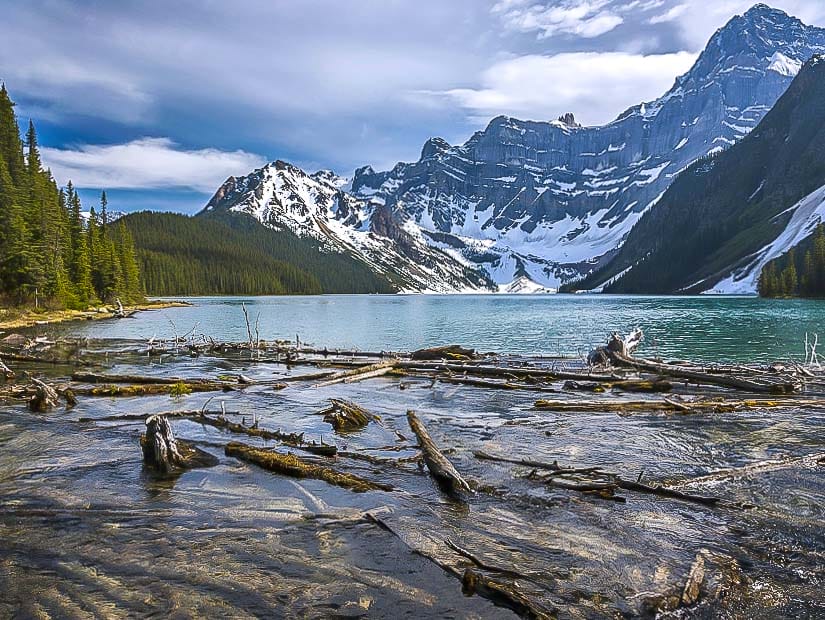
To get off the beaten track from Waterfowl Lakes, consider walking a two-hour return hike to Chephren Lake.
The picture-perfect lake sits at the base of White Pyramid, Howse Peak, and Aiguille Peak. The trail is easy but can be muddy and has lots of roots, so watch your step.
Getting to Chephren Lake: There’s a small public parking lot in Waterfowl Lakes Campground, and this is the starting point for the hike to Chephren Lake.
15. Beyond Banff: Abraham Lake
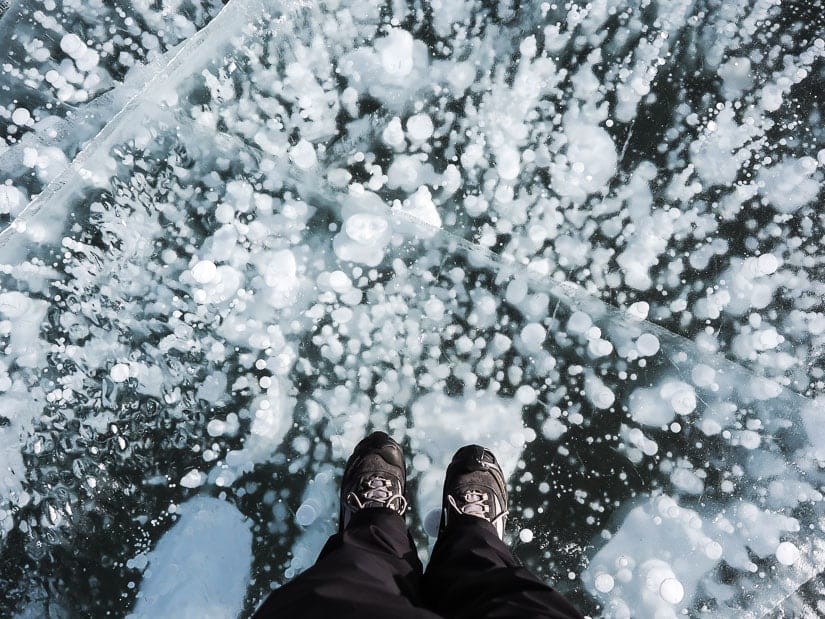
To round this list off with a 15th entry, I’m including one lake just outside of Banff National Park, Abraham Lake on the David Thompson Highway in Alberta’s Nordegg Region.
The lake is actually a human-made reservoir from the damning of the North Saskatchewan River, which originates at Saskatchewan Glacier in Banff and flows on toward Edmonton.
The scenery around Abraham Lake is stunning, not to mention it is Crown Land so you camp beside the lake for free (note there is now a small annual fee for Crown Land Camping in Alberta).
There are several great hikes and waterfalls around Abraham Lake, and in winter, it is worth the detour to see the famed methane ice bubbles of Abraham Lake.
If you’re visiting the area winter, also consider journeying up to Jasper National Park. Here’s my guide to visiting Jasper in winter.
FAQ about Lakes in Banff National Park
Can you swim in Banff lakes?
Yes, nothing is stopping you (legally) from swimming in any lakes in Banff National Park. However, the icy cold water most certainly will! As most lakes in Banff are glacially fed, they are freezing cold. When I was a kid, my Dad actually swam in Lake Louise and Moraine Lake. Everyone around thought he was crazy! The water is so cold that it physically hurts after a few seconds.
Which lakes in Banff are best for swimming?
If you insist on going for a swim in a lake in Banff, the best option is Johnson Lake, which is not glacially fed so it’s not quite as cold (plus it has an actual sandy beach!) Another good swimming option is Cascade Ponds, near the start of the Minnewanka Scenic Drive. Herbert Lake has a diving board on the mountain side shore, but get ready for a shock!
Which lakes can you ice skate on in Banff?
For the best maintained (and safest) ice skating experience on a lake in Banff, nothing beats the rink on Lake Louise, which is maintained by Fairmont Chateau Lake Louise.
It is also possible to ice skate on Two Jack Lake and Lake Minnewanka early in the season, but only once the ice is thick enough, usually around December. Later in the season, the lakes usually get covered in snow. Never ice skate without researching and testing ice thickness first; people fall through and sometimes die every year.
Is fishing allowed in Banff lakes?
Yes, fishing is allowed in some lakes in Banff National Park. It is important to note, however, that a national park-specific fishing permit is required (different than a provincial one), and there are specific regulations that you must be familiar with. Motorized boats are only allowed in Lake Minnewanka.
Is there a public swimming pool in Banff?
There is a small public swimming pool in Banff town at Sally Borden Fitness and Recreation. In nearby Canmore, try the excellent swimming pool and other recreational facilities at Elevation Place. There’s also the hot spring pool at Upper Hot Spring on Suphur Mountain.
Which hotels in Banff have swimming pools?
There is no shortage of hotels in Banff with swimming pools. Here are some of the best ones:
- Moose Hotel & Suites (see on Booking / Agoda / TripAdvisor) Indoor pool and rooftop hot tubs
- Fairmont Banff Springs Hotel (see on Booking / Agoda / TripAdvisor) Banff’s most famous hotel, indoor and heated outdoor pools
- Rimrock Resort Hotel (see on Booking / Agoda / TripAdvisor) Indoor pool, on Sulphur Mountain
- Banff Park Lodge (see on Booking / Agoda / TripAdvisor) Budget choice with indoor pool
- Tunnel Mountain Resort (see on Booking / Agoda / TripAdvisor) Another budget choice with indoor pool
Well, that sums up my list of the best lakes in Banff National Park that are easy to reach. If you have any questions, or I’ve missed a good one, please feel free to comment below!

